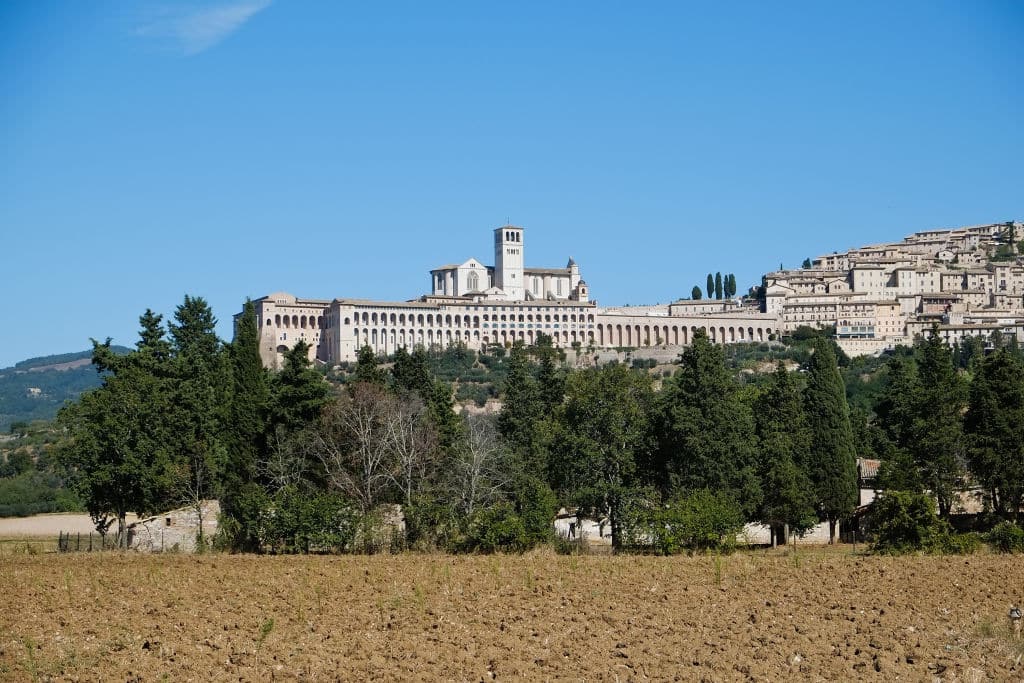There’s every chance that Saint Francis of Assisi would be mystified, if not appalled, by the city that is famous because of him.
Lavishly-endowed basilicas, coachloads of tourists and pilgrims swarming around his tomb, the money-making machine that any modern pilgrim site is nowadays. It all represents the antithesis of what Il Poverello – “the little poor man” in Italian – stood for: radical simplicity and humility, and a rejection of “the economic system of calculated wealth”, says Donald Spoto in <em>Reluctant Saint: The Life of Francis of Assisi</em>.
It was bedlam when the Catholic Herald pilgrim group entered the Basilica di San Francesco’s lower chamber, which is blanket- ed in pre-Renaissance frescos considered one of the most precious collections in all of Italy. The Irish friar acting as our guide kept warning us to not block the aisles or the ushers “will kill you”. Our radio headsets kept cutting out as we wove our way through the crowds. It felt a long way from Francis’s “Canticle of the Creatures” prayer and “Sister Moon and the stars”.
Nonetheless, I suspect Francis would be sympathetic towards modern-day Assisi. He did not shy away from the uncomfortable realities of life and human nature. He also was a reconciler, as illustrated by his famous encounter with the man-eating wolf of Gubbio, which he tamed and persuaded the Gubbio residents to forgive and adopt.
Assisi itself manages to reconcile its contradictions and paradoxes each day. After the coach parties and cars have departed, “an atmosphere of serene mysticism and deep inner peace” descends on the city, says Derry Brabbs in <em>Pilgrimage: The Great Pilgrim Routes of Britain and Europe</em>.
We entered Assisi through Porta Nuova, the eastern gate on the opposite side of the city to Francis’s basilica. We walked towards his church singing the Litany of the Saints. Unlike arriving in Santiago de Compostela, which teems with rucksack-laden pilgrims, we stood out with our hiking gear and walking sticks amid crowds that came by coach, car or train.
We processed past the Basilica di Santa Chiara. Like Francis, Saint Clare was initially shunned by the city for turning her back on the social hierarchy and commercial interests of 13th-century Assisi. Inside her church hangs the crucifix from which Francis heard a voice telling him to “go and repair my church which, as you see, is all in ruins!”
At first Francis interpreted the words literally as referring to the small San Damiano church in which the cross initially resided – and which still stands, close to the eastern gate – before setting his sights on the whole Church and forming the largest religious community in Catholicism.
Among the many images of Francis one encounters is a painting by Giotto, which is believed to be reasonably life-like and based on descriptions from people who knew the saint himself. His ears stick out and he looks rather fragile – his habit on show in the basilica is particularly diminutive (he was about 5 feet tall, if that). Another memorable image shows a six-winged seraph bestowing the stigmata with what looks like lasers shooting out and hitting their targets. The friar told us that the holes in his body even contained the nails.
Early in the morning or later at night, if you wander the narrow empty streets that wind through the different levels of Assisi, you can sense better the solitude and spiritual calm that Francis sought out in his caves and hermitages. And like Compostela, there is something about the solid stone walls of Assisi that is reassuring, even meaningful.
The longer one stays in Assisi, the more one realises that the typical presentation of St Francis the peacemaker and champion of animals is rather simplistic. His life was full of hardship and turmoil, both physical and emotional. Outside his basilica stands a statue of Francis as a soldier mounted on his charge – both their heads are utterly downcast. After Francis headed off to battle, he was taken prisoner and held for two years. When he returned, though still young, he was a changed man and unable to settle back into his previous life of privilege and cavorting with friends.
Hence you can visit the courtyard of the Bishop’s Palace where Francis stripped naked in front of his parents and various city and church officials. He handed his clothes to his father, saying: “I give these back to you. From now on I have one father; the Father in Heaven.” For those unable to make such a leap of faith and willpower, Bar San Francesco – near where we stayed and within sight of the main basilica – serves excellent Negroni cocktails to accompany the sun setting over Assisi and the verdant valley below.
<em>James Jeffrey is the Herald’s official pilgrimage guide</em>.



